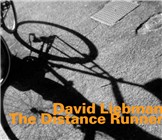Home » Jazz Articles » Album Review » David Liebmam: The Distance Runner
David Liebmam: The Distance Runner
As anyone who has performed live will attest, it's one thing to get on stage with a group—no matter how small—and another to venture there alone. The best improvisation may be all about working without a safety net, but when you're playing with other musicians, there's an inherent one nevertheless. Falter within a group and someone may be able to pick you up and help you recover. Falter on your own and, well, you're on your own.
Solo performances on linear instruments present inherently greater risks than those on piano or guitar, for example. Without a vivid imagination and an ability to imply what might not be obvious, a solo saxophone performance runs the danger of monotony. Fortunately, Liebman—often considered John Coltrane's torch bearer—is more than innovative enough to carry this nearly hour-long performance a capella. As significant and influential as Coltrane was, his focus and evolutionary goals were more specific, whereas Liebman has operated in a considerably greater number of musical contexts—evidenced by his four other releases this year, from the fusion of Flashpoint (Tone Center) to the intimate interplay of Manhattan Dialogues (Zoho), the mainstream Lieb Plays Wilder (Challenge), and the surprising simpatico of his teaming with Ellery Eskelin on Different But the Same (Hatology).
"The Loneliness of a Long Distance Runner: Mind and Body" opens the program on a spacious and lyrical note. Liebman is often described as expressionistic, but while most consider that to mean the articulation of extreme emotions, he's also capable of deeper subtleties. Switching from soprano to tenor for "Colors: Red, Gray, Yellow," Liebman demonstrates one aspect of a compelling soloist—the ability to suggest a simple motif, gradually developing it until it has transformed into something completely different: grist, then, for the next thematic step. Liebman's technical skills, including all manner of extended techniques, allow him the broadest range of articulation. His performances combine the traditionally melodic with the abstractly textural, making for improvisations that are as visual as they are aural.
Liebman builds even more diverse landscapes with wooden flute on "Mother, Father," and most notably on the fifteen-minute "Time Immemorial: Before, Then, Now, After," where he responds to a series of sampled sounds. His reading of Sidney Bechet's "Petite Fleur" and Coltrane's "Peace on Earth" demonstrate how it's possible to expand the language of tradition and make it deeply personal.
It is, in fact, the very intimacy of The Distance Runner that transcends any potential limitations, making those fortunate to have been members of the audience the envy of those who, thankfully, can still experience it vicariously through this fine recording.
Track Listing
The Loneliness of a Long Distance Runner: Mind and Body; Colors: Red, Gray, Yellow; Petite Fleur; The Tree: Roots, Limbs, Branches; Mother, Father; Time Immemorial: Before, Then, Now, After; Peace on Earth.
Personnel
Dave Liebman
saxophoneDave Liebman: soprano and tenor saxophones, wooden flute.
Album information
Title: The Distance Runner | Year Released: 2005 | Record Label: Hat Hut Records
< Previous
AllAboutJazz-New York's Best of 2005
Comments
Tags
For the Love of Jazz
 All About Jazz has been a pillar of jazz since 1995, championing it as an art form and, more importantly, supporting the musicians who create it. Our enduring commitment has made "AAJ" one of the most culturally important websites of its kind, read by hundreds of thousands of fans, musicians and industry figures every month.
All About Jazz has been a pillar of jazz since 1995, championing it as an art form and, more importantly, supporting the musicians who create it. Our enduring commitment has made "AAJ" one of the most culturally important websites of its kind, read by hundreds of thousands of fans, musicians and industry figures every month.




















